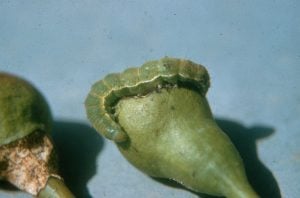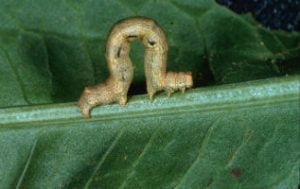Helicoverpa
The native budworm Helicoverpa punctigera and the cotton bollworm Helicoverpa armigera (also known in Australia as tobacco budworm, tomato grub, corn earworm) can attack pome fruit from pink bud through to early fruit development.
H. armigera has developed resistance to a wide range of pesticides and is generally more difficult to control. In southern Queensland H.armigera overwinters as diapausing pupae in the soil under late summer crops and emerge in spring during October but do not become the dominant species until mid- summer and autumn. H.punctigera breeds on flowering plants in inland Australia and in southern parts of Australia overwinters as pupae from which moths emerge in spring. In Victoria H.punctigera emerges before H.armigera. Both species are capable of long-distance migration on high altitude winds that precede cold fronts. Migrating H.punctigera arrive in southern fruit growing states in August and start laying eggs. Pheromone traps can be used to monitor activity of both species separately because they have different pheromones, requiring use of separate traps.
In pome fruit growing regions, the moths can invade orchards from pastures and other crops. Often this means that the moths have mated before arriving in the orchard around the time fruit trees are starting to flower. Pheromone traps only capture male moths, not females, and capture of males indicates females are likely to be present and laying eggs. Because the eggs are laid during the time that bees will be active it is important to make careful choices of control measures.
Budworm larvae bore into developing flower buds, flowers, developing fruitlets and unfolding leaves, and can cause considerable damage and fruit drop. Damaged fruit that remains on the tree may become deformed by deep depression with scar tissue. These scars are larger than those caused by apple dimpling bug and the deformities are distortions rather than dimples. Some chemical control choices will affect: bees and therefore pollination; biocontrol agents that prey on the eggs of Helicoverpa and other pest species may be affected; and the costs of counteracting the side effects may outweigh the benefits of controlling the budworms.

Photo: Heliothis (Helicoverpa) larva and damage (David Williams, Agriculture Victoria)
Loopers
Loopers are the larvae of Geometrid moths and get their common name from their distinctive looping or ‘inching’ action. Loopers attacking pome fruit are apple looper Phrissogonus laticostata, pome loopers Chloroclystis testulata and C. approximata, and twig looper Ectropis excursaria. Loopers feed on the leaves and, when feeding on fruit, generally graze the fruit surface making shallow damage distinguished from LBAM damage by occurring on exposed rather than protected surfaces of the fruit.
Occasionally loopers create crescent shaped series of small deeper single holes when the caterpillar anchors itself with its hind prolegs while it bores a hole and then pivots sideways, like a mechanical excavator, to make other feeding holes while anchored to the same spot. As fruit matures the wounds caused by the loopers become corky and sometimes develop into small lumps but generally they remain shallow and concave.
The adult looper moths are rarely seen because they are well camouflaged when resting on bark. The larvae have a habit of remaining still if they sense the presence of a predator (or human). Larvae have 3 pairs of true legs on the thorax and, unlike budworms, have only two pairs of abdominal prolegs that are at the end of the body. Budworm larvae, like most moth larvae, have prolegs on each abdominal segment. The looping action of the looper larvae is the result of having prolegs only towards the rear of the abdomen.

Photo: Looper (David Williams, Agriculture Victoria)
Management
Management of budworms and loopers involves a combination of weed management, biological control, entomopathogens, early season monitoring, and careful selection of pesticides to avoid disrupting predators and parasitoids that would otherwise manage to keep other pest below economic thresholds. Apple looper has a range of hosts including Acacia. Budworms feed on a wide range of weeds such as deadly nightshade, Noogoora burr, thistles, capeweed, dock, fat hen, and marshmallow. Management of those weeds prior to flowering of pome fruit will not only reduce incidence of budworms but will also help reduce populations of LBAM and harlequin bugs. This does not mean creating bare earth in the inter-row! Biological control agents such as parasitoid wasps require access to flowering plants for energy sources like sugar, so it is important to maintain a balance of plants in the inter-row without promoting the weeds mentioned above.
Trichogramma wasps parasitise budworm eggs and probably also looper eggs. A small black wasp Microplitis demolitor parasitises young budworm caterpillars. The predatory shield bugs Cermatulus nasalis and Oechalia schellenbergii attack Helicoverpa and other caterpillars. Green lacewing larvae, lynx spiders, and red and blue beetles are known to prey on budworms. Small caterpillars can be controlled by applying sprays containing the entomopathogenic bacteria Bacillus thuringiensis (Bt). Once the larvae have grown beyond the third instar, they are probably beyond control by Bt alone and a registered chemical insecticide may be required. Choose carefully to minimise impact on other biocontrol agents. Refer to Chapter 6 of the IPDM Manual for information about side effects on beneficial species.
Monitoring
When monitoring for loopers, the first thing entomologist David Williams does when he walks into a block is have a look at the trees.
“If I can see insect dropping on leaves and a few chewed leaves, I stand still and quiet, letting only my peripheral vision watch for movement. You’re a threat to the loopers so they stay still and watch you, but if you can stay still long enough then they will start moving again and that’s when you spot them.”
Monitoring for eggs during the fruit tree flowering period can be done at the same time you are doing blossom tapping to detect dimple bugs and thrips. Small loopers may be dislodged into the container and if that occurs then it would be prudent to look for eggs and other small larvae amongst the flowers. If the orchard is surrounded by pasture or field crops you may want to position some pheromone traps along the border to detect movement of moths into the orchard.
After petal fall the ‘one-minute tree inspection’ should be used to search for larval feeding activity (for more information on the one-minute tree inspection’ see the IPDM Manual). Pears are particularly attractive to twig looper and the first signs of activity are usually presence of small cylindrical pellets of faecal matter on the upper surface of leaves. These leaves may not have been eaten but the larvae producing the pellets are likely to be detected feeding on leaves on twigs or branches above where the pellets were found. Twig loopers are sensitive to movement and will become immobile while imitating a small twig (hence the name). Once you detect the pellets, stand quietly and do not make any sudden movements but cast your eyes over the leaves. Often you will detect slight movement in your peripheral vision which then allows you to home in on the larvae.
Budworm and looper damage can continue through the season so maintain awareness while you conduct weekly tree inspections.
Insecticide applications should be a last resort because some of the suitable pesticides may also be registered against codling moth, and leafrollers like LBAM, and have restrictions on the number of applications permitted per season. The most likely timing for control of loopers will usually coincide with sprays against codling moth, therefore negating the need for additional sprays to control either pest.
Acknowledgements
This article is republished from the Australian Apple and Pear IPDM Manual (2019 edition, HortInnovation), prepared by David Williams1 and Oscar Villalta1 with contributions by Stephen Quarrell2, Kevin Dodds3, Paul James4, Alison Mathews5 and Stewart Learmonth5
1 Agriculture Victoria; 2 TIA; 3 NSW DPI; 4 Lenswood Cooperative, 5 DPIRD WA
